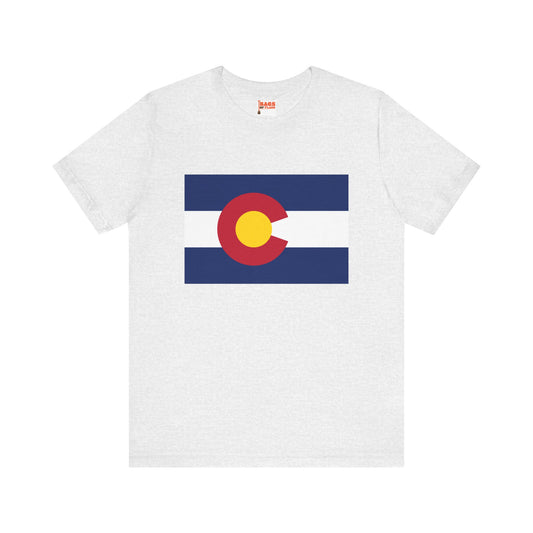-
Colorado Backpack
Regular price $59.79 USDRegular priceUnit price / per -
Colorado Pillow
Regular price $22.65 USDRegular priceUnit price / per -
Colorado Mug
Regular price $11.65 USDRegular priceUnit price / per -
Colorado Sweatshirt
Regular price $34.15 USDRegular priceUnit price / per -
Colorado Trucker Cap
Regular price $14.90 USDRegular priceUnit price / per -
Colorado Flag Sweatshirt
Regular price $34.15 USDRegular priceUnit price / per -
Colorado Leather Patch Hat
Regular price $18.85 USDRegular priceUnit price / per -
Colorado Hoodies
Regular price $34.40 USDRegular priceUnit price / per -
Colorado T-shirts
Regular price $22.79 USDRegular priceUnit price / per -
Colorado Flag Hoodies
Regular price $34.40 USDRegular priceUnit price / per -
Colorado Flag T-shirts
Regular price $22.79 USDRegular priceUnit price / per -
Colorado State Flag – Polyester Printed Banner 3x5 ft
Regular price From $37.06 USDRegular priceUnit price / per
Collection: US State: Colorado CO flag
The Colorado flag is a symbol of pride and identity for the state's residents. Its design and colors hold significant meaning, reflecting the state's history and values. We will explore the flag's journey from its adoption to its relevance in today's society.
Overview of the Flag's Design and Colors

The flag of Colorado presents a vivid tableau that captures the essence of the state's natural beauty and resources. Central to its design are three horizontal stripes that carry significant meaning. The top and bottom stripes, painted in a rich blue, reflect the endless skies that canopy over the state, offering a sense of vastness and freedom. Between these blue bands lies a pristine white stripe, invoking images of the majestic, snow-covered Rocky Mountains that define much of Colorado's topography.
Dominating the flag's field is a large circular red "C," encircling a golden disc. This bold "C" signifies the state's initial and mirrors Colorado's red earth, which is rich in minerals and history. The golden disc inside the "C" pays homage to the abundant sunshine that bathes the state, contributing to its reputation as a place of vibrant natural light and life. Each element of the flag’s design harmonizes to narrate Colorado’s geographical diversity and environmental riches, making it a compelling emblem of the state's identity.
Historical Context and Evolution
The journey of the Colorado flag began in the early 20th century, with its official adoption on June 5, 1911. The flag's original design, conceived by Andrew Carlisle Johnson, has undergone minor modifications. Still, its core elements have remained unchanged, a testament to its enduring appeal and representation of Colorado's identity. While the flag’s design was initially created to symbolize the state’s natural beauty and resources, it also became a canvas reflecting Colorado's historical evolution and aspirations.
The original legislation did not specify the flag's dimensions and the exact shades of its colors, leading to variations in its appearance. It wasn’t until 1929 that the General Assembly specified the shades of red and blue, aligning them with the United States flag to foster a deeper sense of unity and patriotism. Further refinement occurred in 1964, with an adjustment to the diameter of the gold disc, ensuring the flag’s elements remained proportional and visually harmonious. These changes, while subtle, highlight the flag’s adaptability and the importance of its role as a state symbol, ensuring it accurately reflects the spirit and values of Colorado throughout its history.
Symbolism of the Colorado Flag
The symbolism in the Colorado flag is a poignant reflection of the state's rich natural landscape and historical wealth. The bold blue stripes are more than just visual elements; they embody the expansive Colorado skies, symbolizing endless opportunities and a spirit of freedom. Nestled between these azure bands, the white stripe captures the majestic purity of the Rocky Mountains, a hallmark of the state's geography.
The central red "C" is a vibrant testament to Colorado's red earth, a nod to its mineral-rich soil and the pioneering spirit of its people. This "C" not only marks the state by its initial but also envelops a golden disc, representing Colorado's abundant sunshine. This sunshine is pivotal, fostering the state's diverse ecosystems and supporting its reputation as a place of vitality and growth. Each component of the flag's design intricately weaves together to create a narrative of Colorado's environmental bounty and its enduring connection to its natural and historical roots.
The Colorado Flag in Today's Society
Today, the Colorado flag is prominent across a variety of settings, both within the state and beyond its borders. It proudly flies atop government facilities and educational institutions and is a common sight at state and national events, symbolizing Colorado's spirit and values. Its design, steeped in historical significance and natural beauty, resonates with residents and visitors alike, serving as a source of state pride.
In military ceremonies, the Colorado flag is displayed with reverence, embodying the honor and courage of those who serve. During national celebrations, the flag represents the state's contribution to the fabric of American society, showcasing Colorado's rich heritage and diverse culture.
Despite its widespread acceptance and use, the flag has sparked discussions regarding its inclusivity and the extent to which it represents all Coloradans. These debates underscore the evolving nature of symbols and their interpretations in society.
Moreover, the Colorado flag has transcended its official uses, becoming an iconic symbol in popular culture. It appears on merchandise, artwork, and social media, illustrating people's deep connection with the state’s natural landscapes and pioneering spirit. This flag's adaptability to different contexts highlights its enduring relevance and the affection Coloradans and admirers from afar have for this symbol.
Additional Facts and Unique Protocols
Displaying and handling the Colorado flag comes with its own protocols, emphasizing the respect and reverence it commands. When the flag is flown alongside others, it will be positioned with prominence, reflecting its stature within the community and the nation. Proper etiquette dictates that the flag should not come into contact with the ground, underlining the dignity that should be accorded to this emblem of state pride. This practice mirrors a broader tradition of flag etiquette observed across the United States, underscoring the flag's symbolic value.
An intriguing aspect of the Colorado flag's protocol is the specification of its dimensions and color shades, which were meticulously defined to ensure uniformity and coherence in its representation. This attention to detail ensures that wherever the flag is displayed, it conveys the intended symbolism and significance accurately.
One lesser-known fact about the Colorado flag is the legislative amendment that fine-tuned the diameter of the gold disc and the shades of the red and blue, a move that further codified the flag's appearance, enhancing its visual impact and recognizability. These measures highlight not only the aesthetic importance of the flag but also its role as a unifying symbol for the state's diverse population.
In conclusion, the Colorado flag's specific display guidelines and the thoughtful consideration behind its design details underscore its importance as a symbol of state pride and heritage, inviting all who engage with it to do so with a sense of respect and appreciation.
























